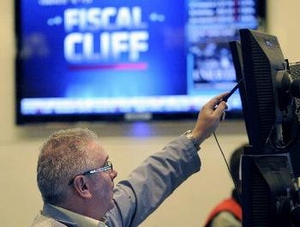
However, prices bounced later in the day, with wire service sources citing widespread short-covering for a significant portion of the rise.
Traders also cited renewed optimism about a Congressional deal to avoid the widely anticipated combination of tax increases and spending cuts commonly known as the fiscal cliff. We should probably expect an upward commodity complex push in the wake of the agreement struck overnight. March corn rose 4 1/4 cents to $6.98 1/4, while the December 2013 contract ended 2012 unchanged at $5.99 3/4 per bushel.
Soybeans also opened weakly Monday morning, with traders seemingly remaining focused upon recent export cancellations, especially those previously intended for China. An announcement that private exporters had reached deals to sell 140,000 tonnes to unknown destination during the current marketing year seemingly did little to boost the market.
Ultimately, news of favorable South American weather, which sustained expectations for large Brazilian and Argentine crops, probably dragged the bean market downward. The fiscal cliff deal may also support the soy complex this morning. January soybeans fell 5 1/4 cents to $14.18 3/4 per bushel; soybean oil gained 0.22 cents to 49.16 cents/pound, but January meal tumbled $7.1 to $420.6/ton.
The wheat market proved decidedly mixed on the last day of the year, with modest Chicago and Minneapolis losses contrasting rather starkly with sizeable Kansas City gains.
Disappointment with the results of the weekly Export Inspections report probably weighed upon the Eastern Markets, whereas increasing talk of dryness across the Southern Plains very likely supported KC values.
With equity markets expected to surge and the U.S. dollar sliding, wheat futures could also react well to the overnight Congressional agreement. March CBOT wheat slipped 3/4 cent to $7.78, whereas March KCBT wheat posted a surprising 5-cent rise to $8.31; March MGE futures also fell, losing 2 1/4 cents to $8.65 1/2/bushel.
Cattle futures might have proven able to sustain their cash-driven advance from Friday, but the bearish hog market reaction to the quarterly USDA Hogs & Pigs report apparently dragged them downward as well. Indeed, the most-active February cattle contract fell to its lowest level since December 14 Monday, thereby seeming to presage further short-term losses.
It will be very interesting to see how livestock futures react to overnight news of a Congressional deal to avoid going over the fiscal cliff. It seems bullish, but a sustained cattle and hog rebound is in no way guaranteed. February live cattle futures fell 1.27 cents to 132.30 Monday, while April dipped 0.85 cents to 136.37 cents/pound.
As expected, CME lean hog futures reacted badly to the quarterly USDA Hogs & Pigs report, since most of the stated numbers modestly exceeded forecasts. The most negative numbers seemed to apply for the summer 2013 outlook, which explains the relatively large losses suffered by those contracts.
However, the swine market may come back strongly today, since the Monday afternoon pork report indicated a sizeable increase. Moreover, the passage of the fiscal cliff deal seems likely to give the whole commodity complex a boost. February hogs edged 0.65 cents lower to 85.72 cents/pound on December 31, while the June contract dove 1.75 cents to 97.85.
Cotton futures may also have benefited from short-covering Monday, while some traders may have been making bullish bets based upon recent Chinese purchases. Bulls may also believe cotton prices will have to rise significantly in order to compete with soybeans for acreage across the Southeastern U.S.
As is expected of many commodity markets this morning, cotton futures surged in response to the fiscal cliff deal in early trading. March cotton jumped 0.81 cents to 75.95, while December climbed 0.26 to 79.00 cents/pound.





